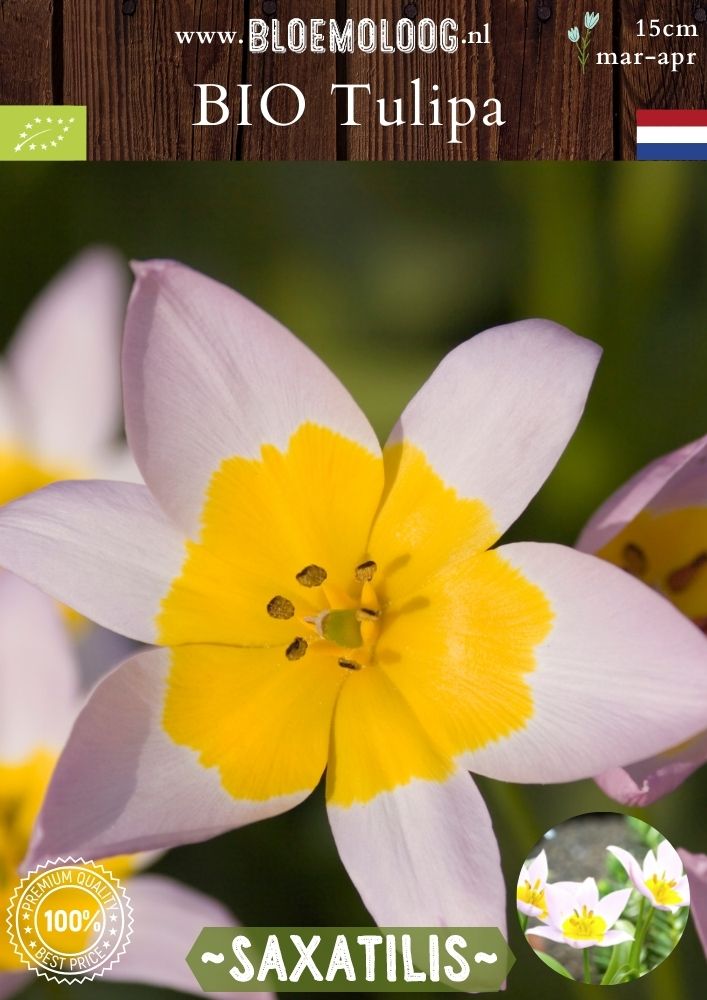Bloemoloog
Organic Tulipa saxatilis (botanical) - Wild tulip | 10 pcs.
Organic Tulipa saxatilis (botanical) - Wild tulip | 10 pcs.
Estimated Shipping Widget will be displayed here!
Couldn't load pickup availability
Organic Wild Tulips
The wild Tulipa saxatilis has lilac flowers with yellow markings on the inside of the petals, which, when open, resemble a round yellow spot in the heart of the flower. The flowers have six petals that form a chalice-shaped bloom and are carried on short, sturdy stems about 15 centimeters tall. As soon as the sun shines on the flowers in March and April, they open into a striking star shape. The tips of the pointed petals curve slightly backward, and the flower reaches about 5 centimeters in diameter.
While not suitable as a cut flower, this tulip is perfect for filling borders, and it also looks lovely in a low container, especially when combined with grape hyacinths. A true gem with a unique color combination that brings joy to pollinators such as bees!
How, Where, and When to Plant Tulipa saxatilis Bulbs
The bulbs of saxatilis need a cold period. Plant them in the ground from September to January, with the pointed end facing upward. Use the rule of thumb: plant the bulb at a depth of 2 to 3 times its own height, and space them 2 to 3 times the width of the bulb apart, which in this case is about 10 centimeters.
Choose a sunny to partially shaded spot in the garden and plant the bulbs in well-draining soil. They prefer light soil with moderate fertility. The soil should not be too heavy or clay-rich, as this can hinder drainage and cause the bulbs to rot. (It’s especially important that the soil doesn’t retain too much moisture during the bulbs’ dormant summer period.)
Tip: If your soil is naturally heavy or clay-based, you can improve structure and drainage by adding organic material, such as compost or well-rotted manure.
Care
Give Tulipa saxatilis a light organic feed in early spring, just after the shoots emerge. Allow the foliage to die back completely after flowering before removing it. The leaves provide the bulb with energy for the next growing season. You can cut them back once they’ve yellowed and wilted, but they generally die back on their own fairly quickly.
If after a few years the bulbs begin to rise above the soil surface, it’s best to replant them at the proper depth in autumn. A good rule of thumb is to plant them 2 to 3 times as deep as the height of the bulb.
Other than that, saxatilis requires very little maintenance and has the ability to naturalize. It reliably returns each year and slowly multiplies over time.
Origin of Tulipa saxatilis
Tulipa saxatilis is a wild tulip that naturally grows in various parts of Europe and Asia. It has a wide distribution, ranging from the Mediterranean region (including Crete, Turkey, and Greece) to Iran and Turkmenistan. Its former name, ‘Candie’, is the old name for Crete.
"Saxatilis" is a Latin term used to describe plants that grow in rocky places or crevices. In the case of Tulipa saxatilis, it means this tulip species naturally thrives in rocky soil or mountainous regions where the ground is stony. It also grows in open grasslands and dry, sandy soils.
Order Information for Organic Tulipa saxatilis
✅ Skal certified: 109459
📦 Packaged per 10 bulbs or choose a volume discount!
💰 Volume discount: E
🛒 Pre-sale – Delivery mid-September!
📬 EU Shipping €8.95 – Free shipping on orders over €100.
Specifications
| Flowering period: | March - April |
| Planting time: | From September |
| Planting depth: | 7 cm deep |
| Spacing: | 7 cm apart |
| Height: | 15 cm tall |
| Flower diameter: | 10 cm wide |
| Position: | Partial shade, sun |
| Soil pH: | Loam or sandy soil - Slightly alkaline/neutral |
| Winter hardiness: | Very hardy |
| Propagation: | Good (naturalizes) |
| Origin: | Greece and surrounding regions |
| Family: | Liliaceae (lily family) |
| Group: | Botanical (wild tulip) |
| Color: | Lilac with yellow heart |
| Bee-friendly: | Yes |
| Fragrant: | No |
| Bulb size: | 5+ |
More tulip varieties

NL-BIO-01
To share




